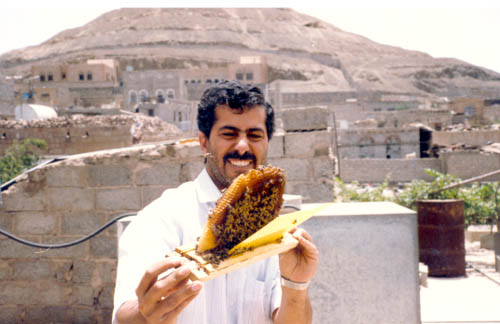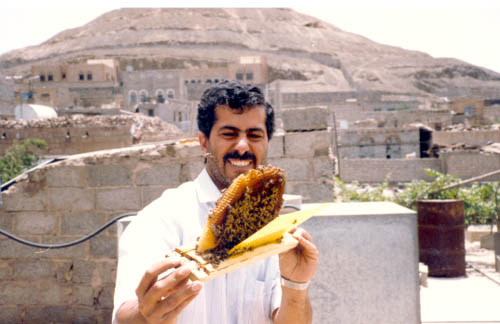
Hadramouts Daw’ani honey: Best in Yemen [Archives:2002/31/Culture]
July 29 2002

BY SALEH ABDULBAQI
YEMEN TIMES STAFF
Some of the Yemeni products gain local and international fame and recognition. Among these national products which already invaded the overseas honey markets is the Dawani honey of Hadramout. Its fame dates back to more than 3,000 years, when it was considered the symbol of high quality, nutrition, and medical benefits proven by many laboratory and scientific researches made in Europe.
According to the Arab Organization for Agricultural Development, the honey of Hadramout costs $70 per kilogram, i.e., at least triple the price of any other Arab honey price. But despite that, demand for this amazing honey is still high.
Hadramout has around 94,388 natural and artificial beehives producing about 70% of Dawani honey in Yemen, which resembles its great significant for the national economy. According to the Central Statistical Organization, the total mount of honey production is about 1,706 tons annually and 17.2% of it is exported to Gulf States, especially Saudi Arabia. Recent researchers proved that the Dawani honey contains a high percentage of sucrose. The honey is unique in color and taste and is considered the sweetest honey on earth. Historical sources indicate that people of Hadramout are the first worldwide to know about bee breeding and honey trade, which started around 3,000 years ago.
The main honey-producing area of Hadramout is (Wadi Thakba), a village located between Wadi Dawan and Mukalla. French scholar, Jaklen Burn, who works in antique exploration in Hadramout discovered many strange drowns on rocks which she thought were part of forts and towers, but later Dr. Abdulqader Ba Faqeeh discovered that those drowns were no other than beehives.
Another honey produced in Hadramout is the lotus honey (Bagiah). A study by Dr. Gazi Abdulhakeem, entitled Researches on developing honey industry in Hadramout shows that Bagiah is produced once in the fall season of every year and one single hive can produces 3 to 7 kilograms of honey.
Researcher Faiza Saleh, the associate teacher in plant protection in the College of Agriculture of Aden University proved that lotus honey is distinguished in its golden color and high degree of glueyness in addition to its unique taste. As for the medical values, the researcher indicated that (Bagiah) honey is the most medically beneficial in the Arab Peninsula and can be used for acidity, ulcer, diabetes and pneumonia-related medical treatments. Besides, it is a source of energy for the body and enhances blood circulation.
The third other type of honey is called (al Maria) and is only consumed locally.
In conclusion, Hadramout is blessed for the wonderful honey it produces. However, there is no doubt that the Dawani honey has a lot of secrets still unrevealed. It may take years and decades until the true values of this honey are exposed. This encourages more researchers to Wadi Dawan to explore the mystical secrets of the famous Hadramout Dawani honey.
——
[archive-e:31-v:2002-y:2002-d:2002-07-29-p:./2002/iss31/culture.htm]


